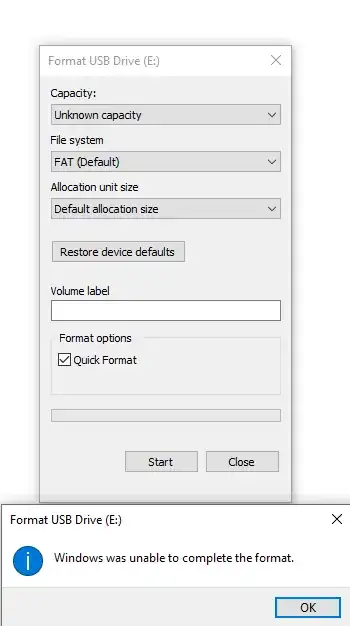I would suggest following this guide to try and use DISKPART to fix the usb drive before giving up... (except maybe format as FAT32 instead of NTFS)
https://www.windowscentral.com/how-clean-and-format-storage-drive-using-diskpart-windows-10
commands are as follows (from the guide for posterity)
Open Start. Search for Command Prompt, right-click the top result, and
select the Run as administrator option. Type the following command to
run DiskPart and press Enter:
diskpart
Type the following command to list all the active drives and press
Enter:
list disk
Type the following command to select the drive that you want to clean
and press Enter:
select disk DISK-NUMBER
In the command, replace DISK-NUMBER with the drive number you want to
repair as it appears in the "Disk" column. If you do not perform this
step correctly, you could erase the wrong drive. Proceed with caution.
Type the following command to wipe out the drive and press Enter:
clean
Type the following command to confirm the drive still selected and
press Enter:
lisk disk
Quick note: The output should include an asterisk (*) next to the
selected drive.
Type the following command to create a new partition and press Enter:
create partition primary
Type the following command to select the new primary partition and
press Enter:
select partition 1
Type the following command to make the partition active and press
Enter:
active
Type the following command to format the partition using the NTFS file
system, set a drive label, and press Enter:
format fs=FILE-SYSTEM label=DRIVE-LABEL quick
In the command, replace FILE-SYSTEM with the name of the file system
you want to use, such as NTFS or FAT32, and replace DRIVE-LABEL with
the name of the drive as you want it to appear in File Explorer. The
quick option is optional to perform a format more quickly. However, if
you are not sure about the drive's condition, it is best to skip the
option. Just remember that depending on the hard drive's size, the
format could take a long time.
This example formats the drive using the NTFS file system and names
the partition "Data":
format fs=ntfs label=Data quick
Type the following command to assign a letter and make the drive
available in File Explorer and press Enter:
assign letter=DRIVE-LETTER
In the command, change DRIVE-LETTER for the letter you want the drive
to use, which is not assigned to another device.
This example assigns the "G" letter:
assign letter=g
Type the following command to terminate DiskPart and press Enter:
exit
Type the following command to close Command Prompt and press Enter:
exit
good luck!

